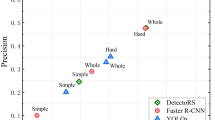Abstract
Collaborative representation-based detection (CRD) has been developed in hyperspectral anomaly detection tasks and testified to be very effective; however, heterogeneous pixels in the background may affect the accuracy of linear representation and make its performance suboptimal. To address this issue, a background purification framework based on linear representation is proposed, in which an automatic outlier removal strategy based on initial coefficients is designed to purify the background. In the proposed method, the classic least squares technique is firstly adopted to obtain preliminary linear representation coefficients, which are positively correlated with its contribution to a central testing pixel. Then, using statistical analysis of the representation coefficients, purified background pixels are obtained. Furthermore, a saliency weight is applied to fully utilize the spatial information of inner window pixels. Extensive experiments with three real hyperspectral datasets show that the proposed method outperforms state-of-the-art CRD and other traditional detectors.
Similar content being viewed by others
References
Li Y F, Li J, He L, et al. A new sensor bias-driven spatio-temporal fusion model based on convolutional neural networks. Sci China Inf Sci, 2020, 63: 140302
He N J, Fang L Y, Plaza A. Hybrid first and second order attention Unet for building segmentation in remote sensing images. Sci China Inf Sci, 2020, 63: 140305
Liu X B, Qiao Y L, Xiong Y H, et al. Cascade conditional generative adversarial nets for spatial-spectral hyperspectral sample generation. Sci China Inf Sci, 2020, 63: 140306
Kang X D, Zhang X P, Li S T, et al. Hyperspectral anomaly detection with attribute and edge-preserving filters. IEEE Trans Geosci Remote Sens, 2017, 55: 5600–5611
Reed I S, Yu X L. Adaptive multiple-band CFAR detection of an optical pattern with unknown spectral distribution. IEEE Trans Acoust Speech Signal Process, 1990, 38: 1760–1770
Matteoli S, Diani M, Corsini G. Improved estimation of local background covariance matrix for anomaly detection in hyperspectral images. Opt Eng, 2010, 49, 046201
Guo Q D, Zhang B, Ran Q, et al. Weighted-RXD and linear filter-based RXD: improving background statistics estimation for anomaly detection in hyperspectral imagery. IEEE J Sel Top Appl Earth Observations Remote Sens, 2014, 7: 2351–2366
Kwon H, Nasrabadi N M. Kernel RX-algorithm: a nonlinear anomaly detector for hyperspectral imagery. IEEE Trans Geosci Remote Sens, 2005, 43: 388–397
Chen Y, Nasrabadi N M, Tran T D. Simultaneous joint sparsity model for target detection in hyperspectral imagery. IEEE Geosci Remote Sens Lett, 2011, 8: 676–680
Xu Y, Wu Z B, Li J, et al. Anomaly detection in hyperspectral images based on low-rank and sparse representation. IEEE Trans Geosci Remote Sens, 2016, 54: 1990–2000
Tan K, Hou Z F, Ma D L, et al. Anomaly detection in hyperspectral imagery based on low-rank representation incorporating a spatial constraint. Remote Sens, 2019, 11: 1578
Li W, Du Q. Collaborative representation for hyperspectral anomaly detection. IEEE Trans Geosci Remote Sens, 2015, 53: 1463–1474
Li W, Wu G D, Du Q. Transferred deep learning for anomaly detection in hyperspectral imagery. IEEE Geosci Remote Sens Lett, 2017, 14: 597–601
Tao R, Zhao X D, Li W, et al. Hyperspectral anomaly detection by fractional fourier entropy. IEEE J Sel Top Appl Earth Observations Remote Sens, 2019, 12: 4920–4929
Vafadar M, Ghassemian H. Hyperspectral anomaly detection using outlier removal from collaborative representation. In: Proceedings of the 3rd International Conference on Pattern Recognition and Image Analysis (IPRIA), Shahrekord, 2017. 13–19
Su H J, Wu Z Y, Du Q, et al. Hyperspectral anomaly detection using collaborative representation with outlier removal. IEEE J Sel Top Appl Earth Observations Remote Sens, 2018, 11: 5029–5038
Zhang Y, Fan Y G, Xu M M. A background-purification-based framework for anomaly target detection in hyperspectral imagery. IEEE Geosci Remote Sens Lett, 2020, 17: 1238–1242
Zhao C H, Wang X P, Yao X F, et al. A background refinement method based on local density for hyperspectral anomaly detection. J Cent South Univ, 2018, 25: 84–94
Tan K, Hou Z F, Wu F Y, et al. Anomaly detection for hyperspectral imagery based on the regularized subspace method and collaborative representation. Remote Sens, 2019, 11: 1318
Goferman S, Zelnik-Manor L, Tal A. Context-aware saliency detection. IEEE Trans Pattern Anal Mach Intell, 2012, 34: 1915–1926
Tan K, Li E Z, Du Q, et al. Hyperspectral image classification using band selection and morphological profiles. IEEE J Sel Top Appl Earth Observations Remote Sens, 2014, 7: 40–48
Liu W H, Feng X P, Wang S, et al. Random selection-based adaptive saliency-weighted RXD anomaly detection for hyperspectral imagery. Int J Remote Sens, 2018, 39: 2139–2158
Herweg J A, Kerekes J P, Weatherbee O, et al. Spectir hyperspectral airborne rochester experiment data collection campaign. In: Proceedings of SPIE, 2012. 839028
Zhao R, Du B, Zhang L P. Hyperspectral anomaly detection via a sparsity score estimation framework. IEEE Trans Geosci Remote Sens, 2017, 55: 3208–3222
Hanley J A, McNeil B J. The meaning and use of the area under a receiver operating characteristic (ROC) curve. Radiology, 1982, 143: 29–36
Acknowledgements
This work was supported by National Key Research and Development Project of China (Grant No. 017YFB-0503903), National Natural Science Foundation of China (Grant Nos. 61922013, 61421001, U1833203), Key Scientific and Technological Projects in Henan Province (Grant No. 192102210106), and Beijing Natural Science Foundation (Grant No. L191004).
Author information
Authors and Affiliations
Corresponding author
Rights and permissions
About this article
Cite this article
Hou, Z., Li, W., Tao, R. et al. Collaborative representation with background purification and saliency weight for hyperspectral anomaly detection. Sci. China Inf. Sci. 65, 112305 (2022). https://doi.org/10.1007/s11432-020-2915-2
Received:
Revised:
Accepted:
Published:
DOI: https://doi.org/10.1007/s11432-020-2915-2




